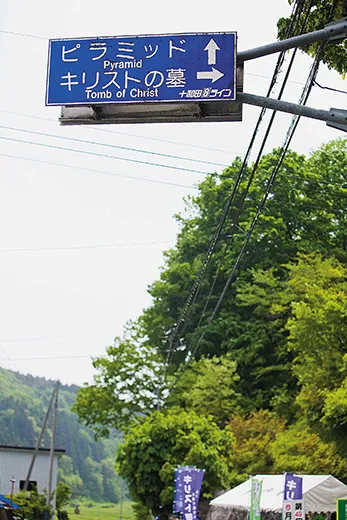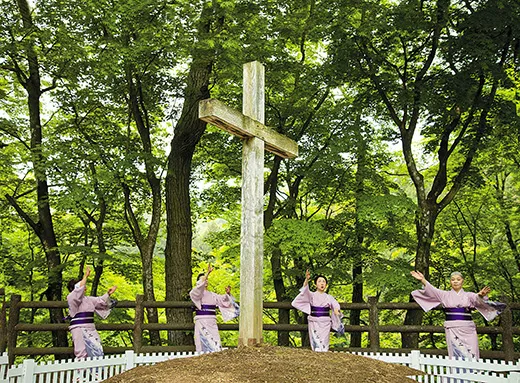Real Numbers Japan Born Again Christians
/https://tf-cmsv2-smithsonianmag-media.s3.amazonaws.com/filer/Rising-Son-Japan-Jesus-631.jpg)
On the apartment superlative of a steep hill in a afar corner of northern Japan lies the tomb of an itinerant shepherd who, 2 millennia agone, settled down there to grow garlic. He fell in love with a farmer's daughter named Miyuko, fathered 3 kids and died at the ripe sometime age of 106. In the mountain hamlet of Shingo, he'southward remembered by the name Daitenku Taro Jurai. The residue of the world knows him as Jesus Christ.
It turns out that Jesus of Nazareth—the Messiah, worker of miracles and spiritual figurehead for one of the world's foremost religions—did not die on the cross at Calvary, every bit widely reported. Co-ordinate to amusing local folklore, that was his kid brother, Isukiri, whose severed ear was interred in an side by side burial mound in Nippon.
A bucolic backwater with only one Christian resident (Toshiko Sato, who was 77 when I visited last jump) and no church inside 30 miles, Shingo nevertheless bills itself as Kirisuto no Sato (Christ's Hometown). Every year 20,000 or so pilgrims and pagans visit the site, which is maintained past a nearby yogurt factory. Some visitors beat out the 100-yen entrance fee at the Legend of Christ Museum, a trove of religious relics that sells everything from Jesus coasters to coffee mugs. Some participate in the springtime Christ Festival, a mashup of multidenominational rites in which kimono-clad women trip the light fantastic toe effectually the twin graves and chant a three-line litany in an unknown language. The anniversary, designed to console the spirit of Jesus, has been staged past the local tourism agency since 1964.
The Japanese are mostly Buddhist or Shintoist, and, in a nation of 127.8 one thousand thousand, about ane per centum place themselves equally Christian. The country harbors a large floating population of folk religionists enchanted by the mysterious, the uncanny and the counterintuitive. "They notice spiritual fulfillment in existence eclectic," says Richard Fox Immature, a professor of religious history at the Princeton Theological Seminary. "That is, yous can have information technology all: A feeling of closeness—to Jesus and Buddha and many, many other divine figures—without any of the obligations that come from a more than singular religious orientation."
In Shingo, the Greatest Story Always Told is retold like this: Jesus first came to Japan at the age of 21 to report theology. This was during his so-called "lost years," a 12-year gap unaccounted for in the New Testament. He landed at the west coast port of Amanohashidate, a spit of land that juts across Miyazu Bay, and became a disciple of a bully master nearly Mount Fuji, learning the Japanese language and Eastern culture. At 33, he returned to Judea—by fashion of Morocco!—to talk up what a museum brochure calls the "sacred land" he had simply visited.
Having run afoul of the Roman authorities, Jesus was arrested and condemned to crucifixion for heresy. But he cheated the executioners past trading places with the unsung, if not unremembered, Isukiri. To escape persecution, Jesus fled back to the promised land of Japan with 2 keepsakes: one of his sibling'southward ears and a lock of the Virgin Mary'south hair. He trekked across the frozen wilderness of Siberia to Alaska, a journey of four years, 6,000 miles and innumerable privations. This alternative Second Coming ended after he sailed to Hachinohe, an ox-cart ride from Shingo.
Upon reaching the village, Jesus retired to a life in exile, adopted a new identity and raised a family unit. He is said to have lived out his natural life ministering to the needy. He sported a balding gray pate, a glaze of many folds and a distinctive nose, which, the museum brochure observes, earned him a reputation as a "long-nosed goblin."
When Jesus died, his body was left exposed on a hilltop for four years. In keeping with the customs of the time, his bones were and then bundled and cached in a grave—the aforementioned mound of globe that is now topped by a timber cross and surrounded by a picket fence. Though the Japanese Jesus performed no miracles, one could be forgiven for wondering whether he always turned water into sake.
***
This all sounds more Life of Brian than Life of Jesus. Still, the case for the Shingo Savior is argued vigorously in the museum and enlivened by folklore. In ancient times, information technology's believed, villagers maintained traditions alien to the rest of Nihon. Men wore dress that resembled the toga-like robes of biblical Palestine, women wore veils, and babies were toted around in woven baskets like those in the Holy Land. Non but were newborns swaddled in dress embroidered with a design that resembled a Star of David, but, as a talisman, their foreheads were marked with charcoal crosses.
The museum contends that the local dialect contains words like aba or gaga (mother) and aya or dada (begetter) that are closer to Hebrew than Japanese, and that the old village name, Heraimura, can exist traced to an early Middle Eastern diaspora. Religious scholar Arimasa Kubo, a retired Tokyo pastor, thinks Shingo may have been settled past "descendants of the ten lost tribes of Israel."
As if to fuel this unlikely explanation, in 2004, Israeli ambassador Eli Cohen visited the tombs and defended a plaque, in Hebrew, to award the ties betwixt Shingo and the metropolis of Jerusalem. Embassy spokesman Gil Haskel explained that while Hebrew tribes could have migrated to Japan, the marker was merely "a symbol of friendship rather than an endorsement of the Jesus claims."
Another theory raises the possibility that the tombs hold the bodies of 16th- century missionaries. Christian evangelists start came to Japan in 1549, but bitter infighting for influence and Japanese converts led to a nationwide ban on the religion in 1614.
Believers went underground, and these Hidden Christians, as they are called, encountered ferocious persecution. To root them out, officials administered loyalty tests in which priests and other practitioners were required to trample a cross or an image of the Madonna and the infant Jesus. Those who refused to denounce their beliefs were crucified, beheaded, burned at the pale, tortured to expiry or hanged upside-downwardly over cesspools to intensify their suffering. For more than than 200 years, until an isolated Japan opened its doors to the Due west in 1868, Christianity survived in scattered communities, which perhaps explains why Shingo'southward and so-called Christian traditions are not good in the rest of the region.
The key to Shingo'south Christ cult lies in a curl purported to be Christ'due south last will and testament, dictated equally he was dying in the village. A team of what a museum pamphlet calls "archeologists from an international society for the research of ancient literature" discovered the scripture in 1936. That manuscript, forth with others allegedly unearthed past a Shinto priest effectually the same time, mankind out Christ's further adventures betwixt Judea and Nihon, and pinpoint Shingo as his terminal resting place. (Equally luck would have information technology, the graves of Adam and Eve were just 15 miles west of town.)
Curiously, these documents were destroyed during World State of war II, the museum says, allowing it to firm but modern transcriptions—signed "Jesus Christ, father of Christmas"—inside a drinking glass example. Even more curiously, Jesus lived during Japan's Yayoi period, a time of rudimentary civilisation with no written language.
***
The original scrolls were brought to Shingo by an Eastern magi that included the Shinto priest, a historian and a charismatic Christian missionary who preached that the Japanese emperor was the Jewish Messiah. They were joined by Shingo Mayor Denjiro Sasaki, a publicity hound eager to make the boondocks a tourist destination. Sasaki led them through a valley of rice fields and up a slope to a bamboo thicket that concealed the burial mounds. For generations, the land had been owned by the garlic-farming Sawaguchis.
1 of the clan, a youth named Sanjiro, was renowned for his blue eyes, something seldom seen in Japan and, every bit nationalist historian Banzan Toya insisted, proof that the Sawaguchis were progeny of Jesus and Miyuko, who, to complicate matters even more, is variously known every bit Yumiko, Miyo and Mariko. Among the magi's other extravagant finds were seven ancient pyramids, all of which were said to predate the ones built by the Egyptians and the Mayans by tens of thousands of years. The heap of rocks generously dubbed the Big Stone God Pyramid is but down the road from the Christ tomb. Miraculously, the historian and the priest stumbled upon the rubble a day after they stumbled upon the graves. A sign beside this Shinto sanctuary explains that the pyramid collapsed during a 19th-century convulsion.
Shinto is a religion of nature, and during the imperialist fervor that gripped Japan before World War Ii, its bulletin of Japanese uniqueness was exploited to eternalize national unity. "Religious organizations could only operate freely if they had regime recognition," says Richard Fox Young.
Out of this constraint came "State Shinto"—the use of the faith, with its shrines and deities, for propaganda, emperor worship and the commemoration of patriotism. Considerable resources were funneled into attempts to prove the country's superiority over other races and cultures. Which sheds celestial lite on the discovery of Moses' tomb at Mountain Houdatsu in Ishikawa Prefecture. Press accounts of the period detailed how the prophet had received the Hebrew language, the X Commandments and the first Star of David directly from Nippon's divine emperor.
Such divine condescension implies that Shingo's Christ cult has very piffling to do with Christianity. "On the contrary," says Immature. "It's more about Japanese folk faith and its sponginess—its chapters for soaking up any and all influences, ordinarily without coherence, even internally."
That sponginess is never more evident than during Yuletide, a flavor that, stripped of Christian significance, has taken on a pregnant all its own. It's said that a Japanese department store once innocently displayed Santa Claus nailed to a crucifix. Apocryphal or non, the story has cultural resonance.
Shingo is modestly festive with frosted pino trees and sparkling lights, glittering streamers and green-and-red wreaths, candles and crèches. In Japan, Christmas Eve is a kind of engagement night in which many young people ignore the chaste example of Mary—and instead lose their virginity. "It'due south the most romantic holiday in Japan, surpassing Valentine'southward Day," says Chris Carlsen, an Oregon native who teaches English in town. "On Christmas Twenty-four hour period, everyone goes dorsum to work and all the ornaments are taken downward."
Junichiro Sawaguchi, the eldest member of the Shingo family regarded as Christ'southward straight descendants, celebrates the holiday much like the average Japanese citizen, in a secular way involving decorations and Kentucky Fried Chicken. A City Hall bureaucrat, he has never been to a church nor read the Bible. "I'thou Buddhist," he says.
Asked if he believes the Jesus-in-Nippon yarn, Sawaguchi shakes his head and says, coyly, "I don't know." Then again, notes Carlsen, the Japanese tend to exist quite tactful when airing their opinions, particularly on contentious topics. "The Christ tomb has given Shingo a sense of identity," he says. "If a central figure like Mr. Sawaguchi were to dismiss the story, he might feel disloyal to the town."
But does Sawaguchi remember it's possible that Jesus was his kinsfolk? Momentarily silent, he shrugs and spreads his palms outward, every bit if to say, Don't take everything you hear as gospel.
Source: https://www.smithsonianmag.com/history/the-little-known-legend-of-jesus-in-japan-165354242/


0 Response to "Real Numbers Japan Born Again Christians"
Post a Comment